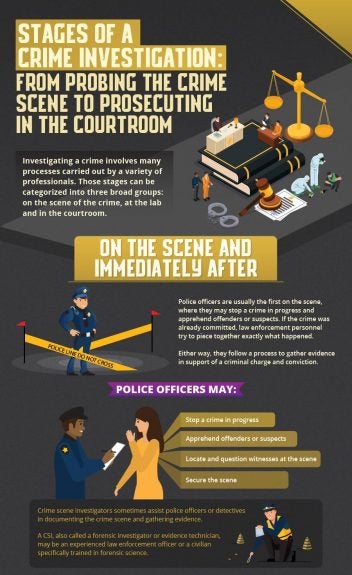Digital forensics has become increasingly relevant, providing investigators with the opportunity to do online detective work and collect evidence. By 2025, the digital forensics market is projected to be worth $6.48 billion, according to a Mordor Intelligence report. For those who are adept at using computers, comfortable in cyberspace and passionate about criminal justice, the digital forensics field may be promising.
What Is Digital Forensics?
Digital forensics is a branch of investigative work that primarily focuses on recovering and analyzing materials from digital devices. The digital forensics specialist is ultimately tasked with recovering information that can be used to prosecute criminals.
History of Digital Forensics
Within the scope of investigative work, digital forensics is a relatively new field. In the 1980s, the field was known as computer forensics; in the 1990s, it became known as digital forensics. The first digital investigators worked for law enforcement agencies. In 1984, the FBI officially established the Computer Analysis Response Team, which assists law enforcement agencies in recovering digital evidence.
In 2008, the FBI established the National Cyber Investigative Joint Task Force. This task force comprises more than 30 partnering agencies from across law enforcement, the intelligence community, and the Department of Defense, according to the FBI. The agency’s main responsibility is to collaborate as a unit in investigating cybercrimes in the effort to protect national security interests. Cybercriminals are developing new ways to thwart digital forensic investigators. With IoT’s evolution, it’s more important than ever that these professionals develop innovative strategies and methodologies to stay one step ahead of these criminals.
Digital Forensics Applications
Digital forensics plays an important role in numerous law enforcement settings.
Cybercrime
Cybercrime can have a devastating impact on organizations in the private and public sectors. Digital forensics professionals are trained in collecting digital evidence that can aid law enforcement professionals in bringing cybercriminals to justice. These professionals have the expertise to analyze network systems and interpret code. This information can help determine the potential vulnerabilities that might be exposed within the network systems or software.
Fraud and Identity Theft
Digital forensics professionals are instrumental in addressing fraud and identity theft. They can recover deleted files stored on computers or digital devices that law enforcement agencies have seized. They can also obtain encrypted or hidden data. This ability makes digital forensics professionals adept in tracking the digital trail of suspected identity theft criminals and providing justice for the victims. This evidence can then be used to prosecute criminals.
Terrorism
Digital forensics plays a unique role in the fight against terrorism. Military professionals can use computer forensics to evaluate vulnerable systems and network infrastructure that terrorists may exploit. They can then create a timeline to interpret what software and systems were exploited, as well as collect evidence of the attack that can be used in the International Court of Justice. Digital forensics can also be used to locate vulnerabilities in computer networks and systems to prevent future cyberterrorist attacks.
Evidence Sources in Digital Forensics
Digital forensics professionals may seek to recover and investigate information from many different evidence sources, including:
- Computer files
- Emails
- Text messages
- Webpages
Together, these and other sources can provide the evidence needed to build credible criminal cases. To assist law enforcement, digital forensics investigators are trained to unearth criminals’ digital fingerprints. Prosecutors can then leverage these digital sources to help them convince a jury to convict a criminal.
In 2017, an Ohio man, Ross Compton, was arrested for burning down his house, which caused $400,000 in damages. He was formerly charged with insurance fraud and aggravated arson. Digital forensics played a significant role in helping prosecutors file these charges. Detectives obtained a search warrant to analyze the digital data from the defendant’s pacemaker. The detectives were able to analyze the digital evidence –– heart rate and cardiac rhythms — during the time when the defendant claimed the fire took place.
Compton claimed that when the fire occurred, he broke a window and escaped from the house with his luggage. After analyzing the digital evidence with the professional assistance of a cardiologist, it was determined that Compton’s narrative of the events was highly improbable. Compton’s heart rate and cardiac rhythms remained stable when, in this case, they should have spiked. Compton died in 2020 prior to the start of his trial.
In a highly unusual criminal case in 2019, the FBI accused an Apple employee, Jizhong Chen, of stealing proprietary information. Apple had hired Chen as a hardware developer for its autonomous vehicle program, “Project Titan.” When his co-workers caught him taking pictures of the team’s workspaces, they became suspicious of his activities. The team alerted the organization’s global security team, which used digital forensics to investigate him.
Upon investigation, it was concluded that he had downloaded thousands of images and files, including graphs, schematics, charts and diagrams. He evaded detection by downloading a significant amount of these files on his personal laptop. After collecting digital evidence, Apple reported Chen’s activities to the FBI, which led to him being officially charged with theft of trade secrets. If convicted, he faces 10 years in prison and a $250,000 fine.
As technology advances exponentially, digital forensics professionals can use their expertise to help law enforcement agencies and prosecutors collect the necessary evidence to prosecute criminals. To protect proprietary information, organizations realize the importance of hiring in-house digital forensics experts. These experts have the knowledge and training to protect trade secrets and proprietary information from being leaked to competitors or foreign governments intentionally trying to steal trade secrets. Their technological prowess enables them to investigate information from different evidence sources.
Entering the Digital Forensics Field
To become a digital forensics professional, having the right academic background is important, as well as the right set of technical competencies.
Educational Requirements
While specific requirements may vary by law enforcement organization, digital-forensics professionals should generally have at least a bachelor’s degree in computer science, computer engineering, cybersecurity or a related field. A master’s degree isn’t always required but can be invaluable for honing core skills and leading to more competitiveness in the job market.
Core Skills
While pursuing a degree in a computer-related field, aspiring digital forensics professionals may gain proficiency in many critical skills, all of which will allow them to add real value to their teams:
- Technical. Digital forensics investigators need to be highly adept at using computers, networks and connected devices. Familiarity with ethical hacking and other cybersecurity skills is a plus.
- Analytical. Analytical abilities are also essential because digital forensics professionals must be able to carefully scrutinize evidence and draw inferences.
- Attention to detail. Successful digital forensics professionals will be highly observant and able to identify even small or obscure pieces of evidence.
- Communication. One of a digital forensics professional’s primary responsibilities is to communicate findings to prosecutors and other law enforcement professionals.
These and other key skills can be cultivated on the job, but also through experience in an academic setting. UCF Online’s criminal justice programs offer curricula designed to help students hone their competencies for long-term professional success.
Exploring Digital Forensics Salaries and Job Descriptions
As for the expected digital forensics salary and job outlook, aspiring investigators may consider several positions.
Information Security Analyst
Information security analysts’ primary duties are to design, implement, test and evaluate information security plans, helping to protect an organization’s network and connected devices. According to the U.S. Bureau of Labor Statistics, the median annual salary for information security analysts was $99,730 in 2019. The BLS projects jobs in this field to grow by 31% through 2029, much faster than the projected average for all professions.
Forensic Computer Analyst
Forensic computer analysts gather and inspect digital evidence, using it to build legal cases or develop strategies for cybercrime prevention. PayScale notes that the average annual salary for forensic computer analysts is about $73,900. Meanwhile, the BLS projects forensic science roles to grow by 14% through 2029.
Cyber Investigator
Cyber investigators (or digital forensics investigators) are in charge of recovering and analyzing digital evidence that’s been linked to potential criminal activity. According to PayScale, the average annual salary for cyber investigators is about $63,600. The BLS doesn’t have an entry for this specific job title, but again, note the general 14% projected growth rate in forensic science roles.
Chief Information Security Officer
Chief information security officers oversee all aspects of a company’s or organization’s information security, developing and implementing plans to prevent fraud or information theft. PayScale lists the average annual salary for chief information security officers as about $162,700. The BLS projects 10% growth through 2029 for the computer and information systems security field.
The Rise of Digital Forensics
One of the reasons the digital forensics field has seen such growth is that the world is increasingly connected; new devices have become commonplace, providing numerous avenues for digital investigation. Some examples include smartphones, tablets, smartwatches and even cloud applications.
Digital Forensics Tools and Strategies
In their pursuit of relevant evidence, digital forensics professionals may implement many tools and methodologies, including:
- Database forensics
- Email analysis
- Online audio and video analysis
- Disk and data capture
- Digital image investigation
Explore the World of Digital Forensics
For those curious to learn more about the digital forensics salary, job outlook and potential career paths, the UCF Online criminal justice degrees are a good starting point.
An online Master of Science in Digital Forensics will provide the skills needed to promote cybersafety and information security. An online Master of Science in Forensic Science, meanwhile, focuses on the more general principles of forensic science and solving crimes. Pursuing a Master of Science in Criminal Justice can provide a well-rounded approach to the ever-changing criminal justice profession. Learn more about these academic paths today.







